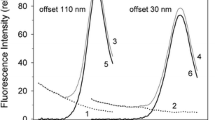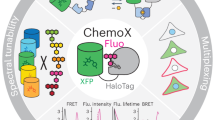Abstract
Evaluation of emission spectra of fluorescent probes used for the monitoring of membrane potential in microbial cells can be greatly facilitated by using synchronously excited spectroscopy (SES). This method permits the suppression of undesirable spectrum components (contributions due to scattered light or cell autofluorescence) and leads to considerable increase in monitored emission intensity and to narrowing of spectral peaks. It allows an efficient fractional decomposition of the probe fluorescence spectra into their free and bound dye fluorescence components. The usefulness of the method was tested by monitoring the accumulation of the fluorescent membrane potential probe diS-C3(3) in yeast cells, which serves as a qualitative measure of the membrane potential.
Similar content being viewed by others
References
Cabanis E.S.: Theory of variable-angle synchronous fluorescence spectra.Anal. Chem. 63, 1323–1327 (1991).
Eminger M., Gášková D., Brodská B., Holoubek A., Stadler N., Sigler K.: Effect of killer toxin K1 on yeast membrane potential as reported by the diS-C3(3) probe reflects strain-and physiological state-dependent variations.Folia Microbiol. 44, 283–288 (1999).
Gášková D., Brodská B., Heřman P., Večeř J., Malínský J., Sigler K., Benada O., Plášek J.: Fluorescent probing of membrane potential in walled cells: diS-C3(3) assay inSaccharomyces cerevisiae.Yeast 42, 1189–1197 (1998).
Gášková D., Brodská B., Holoubek A., Sigler K.: Factors and processes involved in membrane potential build-up in yeast: diS-C3(3) assay.Internat. J. Biochem. Cell Biol. 31, 575–584 (1999).
Johnson D.W., Callis J.B., Christian G.D.: Rapid scanning fluorescence spectroscopy.Anal. Chem. 49, 747–757 (1977).
Plášek J., Dale R.E., Sigler K., Laskay G.: Transmembrane potential in cells: a diS-C3(3) assay for relative potentials as an indicator of real changes.Biochim. Biophys. Acta 1196, 181–190 (1994).
Plášek J., Sigler K.: Slow fluorescent indicators of membrane potential: a survey of different approaches to probe response analysis.J. Photochem. Photobiol. B: Biology 33, 101–124 (1996).
Taylor T.A., Patterson H.A.: Excitation resolved synchronous fluorescence analysis of aromatic compounds and fuel oil.Anal. Chem. 59, 2180–2187 (1978).
Vo-Dinh T.: Synchronous excitation spectroscopy, pp. 167–192 inModern Fluorescence Spectroscopy, Vol. 4 (E.C. Wehry, Ed.). Plenum Press, New York 1981.
Author information
Authors and Affiliations
Rights and permissions
About this article
Cite this article
Plášek, J., Gášková, D., Večeř, J. et al. Use of synchronously excited fluorescence to assess the accumulation of membrane potential probes in yeast cells. Folia Microbiol 45, 225–229 (2000). https://doi.org/10.1007/BF02908949
Received:
Issue Date:
DOI: https://doi.org/10.1007/BF02908949




